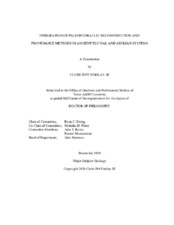| dc.description.abstract | Detrital zircon is a dense mineral used in provenance studies to translate the rock record into spatio-temporal reconstructions of climatic, tectonic, and autogenic processes that shaped ancient landscapes and continue to shape modern planetary surfaces. Such provenance techniques rely on accurately quantifying the abundance and variability of dense minerals, but dense mineral assemblages can be affected by hydraulic sorting during transport of a sediment load. I integrate paleohydraulic reconstruction and provenance techniques to disentangle allogenic and autogenic signals in detrital zircon age signatures in a case study of the Pennsylvanian–Permian Cutler Group in the Paradox Basin of UT and CO. I synthesize paleohydraulic reconstruction methods and demonstrate how to apply them to provenance problems, demonstrate how paleohydraulics and provenance can be used to investigate depositional environment and improve understanding of sediment dispersal patterns in the Paradox Basin, and expand the paleohydraulics and provenance approach to investigate fluvial and aeolian interactions. Measured sections, grain size, and cross-stratification set thickness measurements from outcrops in a source-to-sink transect, along with detrital zircon sampling of fluvial channel and aeolian deposits, were used to reconstruct and identify spatial variations in ancient flow conditions and provenance. Results show that sorting did not affect detrital zircon age signatures in the fluvial or aeolian systems, and instead implicate the mixing of different sediment sources from within the Uncompahgre Uplift, as well from extrabasinal sources. Integration of detailed sedimentologic, paleoflow, sediment provenance, and paleohydrualic datasets indicate that both fan and axial dispersal patterns existed in the Cutler fluvial system, and these interacted with actively uplifting salt walls. Paleohydraulic results also reveal how sediment recycling between coeval fluvial and aeolian systems is likely linked to the combined influence of position within the active flexural foreland basin and salt wall topography and illustrate variable influence of these allogenic drivers on ancient fluvial and aeolian systems. Combining paleohydraulic reconstruction with provenance analysis provides the tools necessary to investigate the autogenic sorting effects on detrital zircon age data, and assess these in the context of allogenic controls on fluvial and aeolian systems. | en |


